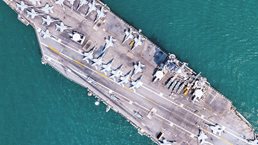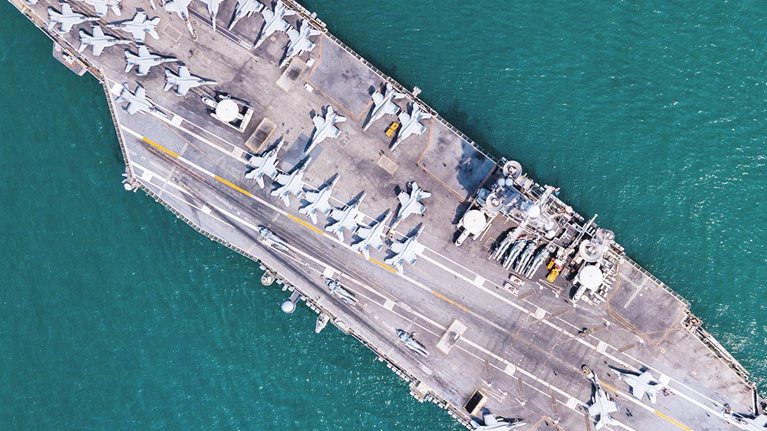The problem will be familiar to nearly all defense chiefs in the developed world: how to chart a course through the competing calls of stretched equipment budgets, significant delays in acquisition systems, and adversaries developing their own capabilities more quickly than ever. While the current COVID-19 crisis is likely to exacerbate these problems, it also presents a once-in-a-generation opportunity to address them. As governments around the world focus on healthcare and other domestic policies, defense departments have an opportunity to reassess how they will balance capability and finance in both acquisition and sustainment.
Over the past two years, audit authorities in five of the G7 nations have warned that the budgets of their defense departments were stretched.1 Since the 2008 global financial crisis and the ensuing fiscal constraints, many developed nations have reined in defense spending significantly: World Bank data show military expenditures in high-income countries falling from 2.8 percent of GDP in 2009 to 2.3 percent in 2018.2 As finance ministries brace themselves in 2020 for the biggest economic shock in at least half a century, we are already seeing signs that defense budgets are being raided to meet the cost of dealing with it.
The picture on overruns looks similarly bleak: five of the G7 countries report significant delays in their acquisition programs.3 One audit authority estimated the cost of systemic delays at 10 percent of the entire equipment budget. Clunky and bureaucratic acquisition processes, inaccurate initial cost or time estimates, and in-year budgetary pressures are all to blame. The effect of COVID-19 on the defense supplier base, parts of which are reeling from the biggest shock in living memory, will probably exacerbate this problem.
Governments can ill afford these delays, for the threat is evolving more quickly than at any point in history and the geopolitical environment is unstable—and made more so by the global pandemic. Typical procurement cycles for traditional weapons systems range from four to 30 years. Those for digital technology last around a year. Unless defense departments can radically change the way they acquire military equipment, they will simply be unable to keep up with the pace of technological change.
Charting a course away from one threat leads all too easily toward another, however. Spending to avoid delays increases the pressure on budgets, while the need to veer and haul to meet the evolving threat forces time trade-offs with other programs. All too often, defense departments focus too narrowly on just one aspect of what’s needed to make an acquisition system fit for the 21st century: a budget overhaul, a “bonfire of bureaucracy,” or a change in the use of data. Our work has found that a successful defense acquisition system has five key ingredients—and all must be in place if a defense department is truly to meet the triple threat of stretched budgets, time overruns, and COVID-19. Never in living memory has the imperative to address threats been stronger, and never has there been a better opportunity.
A clear capability and industrial strategy
The first ingredient of a successful acquisition system is a clear strategy. What threat are we trying to meet, what capabilities must we acquire to meet it, and how will we work with our supplier base in a cost- and time-effective way? But producing and refreshing such a strategy is difficult. Many defense departments conduct such an exercise on a five-year cycle—an increasingly untenable frequency given the pace of change. Strategy reviews also require an extraordinary amount of coordination across governments: typically, the defense department and the economics, finance, trade, and foreign ministries—not to mention the head of government’s office—will all have strong views.
Many governments solve this latter challenge by conducting a centrally led exercise across all of their foreign- and defense-policy imperatives. The United Kingdom publishes a National Security Strategy and Strategic Defense and Security Review about once every five years. It looks at the whole national-security context—from state to nonstate actors and from traditional militaries to cyberforces to natural disasters—and sets out a whole-of-government response. France and the United States follow similar approaches, with the Livre Blanc and Quadrennial Defense Review, respectively.
A government’s high-level strategy should then flow clearly to an equipment program that draws together an understanding of the state of the nation’s current equipment, the solutions available on the market, and the threat picture set out in a national security strategy. It is particularly important that this exercise should be conducted first for all of defense rather than for individual forces. Many of the solutions to meet today’s threat (unmanned air systems and cyber solutions, for example) do not fit neatly into one single military force. Without a strong central guiding hand, defense departments risk gaps or duplication.
With the equipment program decided, a defense department must set out its industrial strategy. How will it work with its supplier base, research institutions, and others to achieve its aims? How will the government balance operational military needs, security of supply, national economic prosperity, and international advantage? The strategy should begin with a market assessment for both defense as a whole and specific subsectors. It should then articulate an overarching strategy to answer the following question: Will the nation develop broad sovereign capabilities, generally buy off-the-shelf capabilities but develop sovereign ones where there is a strong justification, or focus on modifying existing off-the-shelf solutions? Finally, the strategy should set out specific levers for intervention, both at the macro level and the level of individual suppliers. Will the defense department fund academic research if a sovereign capability is lacking? Will it help open up export markets for critical suppliers? Will it look to off-the-shelf overseas solutions in certain areas?
Australia’s 2016 defence white paper describes a whole-of-defense approach that can enhance the industrial base. It includes plans to transform the domestic shipbuilding and submarine industries, two strategically important sectors, with the help of the Defence Cooperative Research Centres Program, the Defence Export Office, and other organizations.
A clear capability and industrial strategy, set out in this way, sets the overall direction for the acquisition system. Without this, it cannot succeed. While a once-in-five-years exercise may be appropriate to set the high-level direction, the strategy must be refreshed more regularly to be meaningful—at least every two years but, more important, in step with the threat it is intended to keep up with.
Would you like to learn more about our Aerospace & Defense Practice?
Balanced budgets
Self-evidently, without the financial means to acquire the equipment in the plan, a defense department will be unable to do so. Yet most defense departments are in exactly that position. Political commitments and sacred cows thwart the best-intentioned attempts to bring budgets into balance, and the media scrutiny involved in tough calls often makes ministers shy away from them.
By a balanced budget, we mean that enough money is available at the right time to acquire all planned equipment and services. This allows defense departments, and the supplier base, to plan for the long term without canceling or delaying projects for lack of funds. It avoids the vicious cycle of project delays that cause cost overruns which, in turn, cause further delays. And it creates headroom for the freedom of movement to introduce new elements to the equipment program as the threat evolves, provided any budgetary headroom is used to provide flexibility in equipment procurement, rather than to fill holes in other areas of the budget. As the speed of the changing threat continues to increase, the amount of headroom should increase accordingly. This feels particularly smart in the current context, given the significantly heightened level of uncertainty over the long-term fiscal position.
How do defense departments move from stretched budgets to balanced ones or, better still, budgets that allow some headroom? Under pressure from finance ministries looking for quick savings, governments are often tempted to salami-slice all programs—often banking savings despite little evidence that they can be achieved. A more systematic approach that simultaneously looks for efficiencies within programs and trade-offs between them is much more likely to yield results.
The first step is to develop a credible baseline: a multiyear forecast of spending by program and project, as well as a clear view of how this stacks up against the budget. That is hard to do: to avoid apparent mismanagement, many projects may underestimate spending; others “sandbag” their forecasts to secure more money.
Once this picture is built, the first step is to look for efficiency levers within projects. For a major advanced economy to do so across its whole equipment program would be extremely time consuming. But a handful of programs usually dominate a typical defense department’s equipment spending. A look at these, plus any that are known to be significantly underperforming, will be the best starting point.
A highly skilled central team should examine the full range of levers, including minimizing the requirements of programs by identifying attempts at “goldplating,” searching for operational improvements within the department or suppliers, and using commercial levers to secure more favorable terms from suppliers. Once these levers have been identified, the mindset and approaches of zero-based budgeting can be used to make trade-offs between them.
First, set out a “survival minimum” equipment program: capabilities that absolutely must be acquired for the security of the nation. All acquisitions beyond this should be grouped in strategic clusters—clear choices, with costs attached, linked to the capability strategy. Ideally, each strategic cluster would itself have a survival-minimum cost and then a series of choices over and above this, including the efficiency levers above. This picture allows the department to make trade-offs within and between areas and to present those trade-offs to the rest of the government. The exercise should be tied to the recurring spending-review process.
Streamlined and tailored processes
Defense departments are no strangers to process. In most major advanced economies, they control more public money than almost any other institution and must spend it appropriately and effectively, ensuring safety and value for money. But too often, the processes are self-defeating—the people running them have incentives only to avoid risk, even at the expense of time and cost. Many defense organizations have a strong tendency to add processes in response to problems but almost never strip out processes that have become redundant.
Defense departments must balance the hunt for ever more robust investment decisions with the need to make some urgent or routine decisions speedily. Where this balance falls depends on the specific acquisition: acquiring a nuclear submarine is fundamentally different from acquiring rifles or back-office software, and the processes must be tailored to reflect this.
All defense departments aspire to have only as many checks and balances as they require, but given the enormous range of acquisitions, no process could ever get it right 100 percent of the time. However, while there may not be a one-size-fits-all process, there is a one-size-fits-all principle: tailoring.
This plays out with a few options. Consider the equipment-approval process. One approach is to define customizable lanes that lay out the approximate approval routes for different types of acquisitions. Off-the-shelf ones are immediately separated from highly complex bespoke items, and urgent one-off requirements are segregated from recurring purchases. Within each lane, the precise process could again be adapted as appropriate. The United States uses this type of approach in its Adaptive Acquisition Framework, published in late 2019.
A second, more extreme, approach involves the near-abolition of process. In lieu of guidelines, which can all too easily be mistaken for requirements, give program owners full accountability for success. Empowered to determine the route, they can spend more time focusing on the risks and requirements of their specific programs and less on irrelevant standardized documents. The right incentives are particularly important; everyone responsible for a program—not just those at the very top—must have strong ones to deliver on time and on budget.
There is no one correct process. The specific processes must be tailored to each defense department, much as they are to the acquisitions it oversees. But departments can redesign their processes in a number of ways. Multifunctional teams can conduct intensive, focused design sprints to develop more streamlined new processes and principles based on collective experience. As an alternative, a test-and-learn approach involving pilot programs can identify challenges and develop solutions without a fundamental rewrite of the rules.
Effective data, put to effect
The successful application of data has had a transformative impact on almost all industries, from banking to agriculture, and retail to manufacturing. Defense departments, however, have been comparatively slow to establish and exploit data reserves.
Typically, departments fail in this respect because they bite off too much by aiming for a complete, permanent solution and give up when the size of the challenge becomes apparent. Often, an incremental approach is far more effective. The initial focus looks at integrating the essential data sets and using them for a conversation on the fundamentals: Which programs are at risk of delays? What is the significance of this on the wider equipment plan? What can we do to mitigate the impact? Once the value is apparent, additional data sets and visualizations can be added incrementally.
Data hold enormous potential to improve acquisitions. At a minimum, the collection of up-to-date data could elucidate, for the first time, exactly how acquisition and sustainment systems are performing, while reducing the amount of process required for oversight. A dashboard could identify, early on, programs at risk for time or cost overruns (including any interdependencies) and enable early intervention. Live monitoring of the whole portfolio could identify upcoming capability gaps, budgetary pressures, and critical decisions and draw attention to the key programs driving these trends. The ability to view programs by type of equipment could maximize the value for money from the setting of strategy.
There is a real opportunity for data to be used not just to make effective and strategic decisions but also to drive down costs and delays. Advanced analytics offers a further opportunity to transform the way departments and their suppliers operate. The optimization of costs and schedules can be overlaid onto equipment plans to ensure that suppliers receive a steady stream of acquisitions so they can optimize production. Predictive maintenance, too, could significantly reduce support costs while simultaneously helping defense departments to minimize equipment downtime.
The Pentagon’s Joint Artificial Intelligence Center has focused on a number of use cases—for example, those involving cybersecurity, humanitarian assistance, the health of war fighters, and back-office automation. The center was founded in 2018 to help the US Defense Department tackle some of the biggest questions through AI—and has proved its worth by taking an incremental rather than a big-bang approach to individual, high-value use cases.

Aerospace and defense spending: What will be the next normal?
People and skills—with the right collective mindsets
Finally, defense departments have often struggled with access to the right mix of skills and talent. Public-sector employment has its own merits, but departments have difficulty attracting and retaining talent because the private sector can offer greater rewards. What’s more, incentives can focus too much on meeting job specifications and avoiding mistakes. Defense departments need a culture in which employees feel empowered to deliver. Departments should also balance the mix of skills, which will change as operational military needs evolve. With workforces largely populated with former military personnel, defense departments must not overlook reskilling efforts to meet these needs.
Financial rewards are not an easy war to win for defense departments—especially as they try to balance their budgets and avoid escalating program costs. But addressing values, culture, and leadership may be relatively simple. Our research has shown that of the four elements of satisfaction most valued by top talent, financial rewards are the least important; leadership, values, and opportunities for growth hold greater weight. It is more valuable for employers to stand out in one dimension while not ignoring the others. Achieving a reputation for the right culture and level of trust can therefore supersede the need to match private-sector salaries.
Departments can do what’s necessary by using tools such as well-designed surveys to get employees to share their mindsets and perspectives on the quality of work practices and enable employees to translate the overall vision into personal meaning. Departments have an opportunity to assume the character of a leadership factory that drives performance by developing and deploying strong leaders or a talent core that creates value by attracting and inspiring top people. Employee surveys can help work out this alignment and allow everyone to work toward a shared vision.
Defense departments must focus not only on attracting talent but also on achieving the mix of skills that matches the capability strategy. An offensive cyber capability, for example, requires skills fundamentally different from those involved in acquiring a fleet of fighter jets, and the distinction must be clear in the sourcing of talent. Departments must also become highly adept at reskilling the current workforce. Traditionally, many serving members of the armed forces become acquirers at headquarters, but the skills required to acquire defense systems do not perfectly match those of soldiers, sailors, and fliers. Defense departments can truly modernize themselves by regularly assessing the skill mix of their workforce and using a mix of tactics: reskilling, recruitment from outside traditional labor pools, and active competition with the supplier base where appropriate.
The current, unprecedented crisis is likely to place even greater strain on already-stretched budgets, adding to delays and making the threat more difficult to keep up with. But this crisis presents a unique opportunity—if ever there was a “burning platform” for defense chiefs, it is now. This crisis creates a moment, perhaps for the only time in our lives, to reshape defense acquisition and sustainment for the 21st century.
This is also a time to ask more fundamental questions, beyond those addressed in this article. Is the historical approach of long-term linear platform development still viable? Are defense departments always the right organizations to acquire and sustain military equipment? Does an approach to acquisition that makes increasingly arbitrary divisions between different parts of the armed forces still make sense? Defense chiefs who address these big questions will come out of this crisis in the strongest position.


